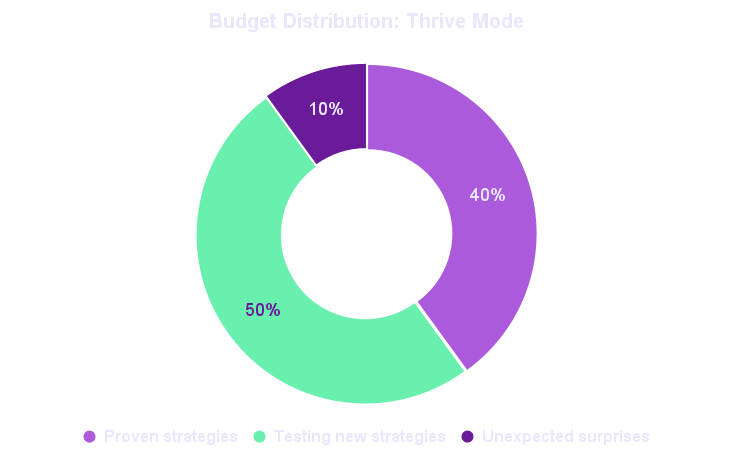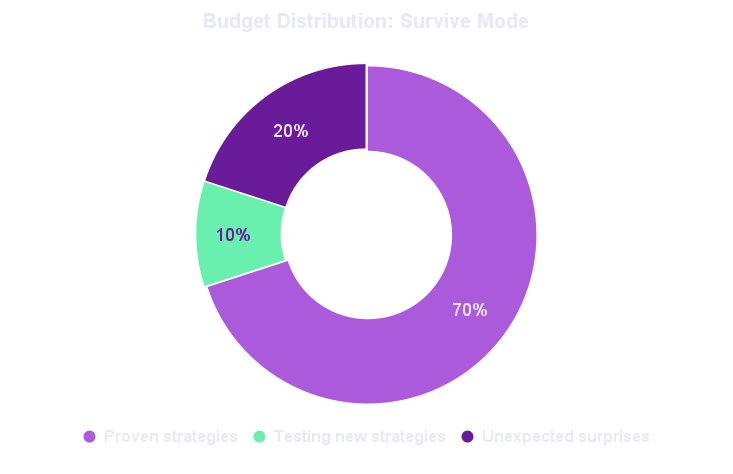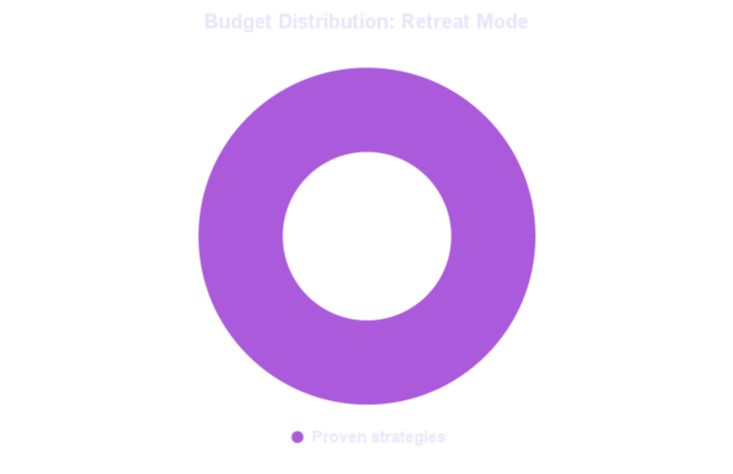I’ve had the opportunity to develop marketing budgets for various companies – from startups and corporations to legacy companies and high-growth ventures. Now, I want to guide you in creating a marketing budget. While I can’t cover every scenario, the principles I’ll share have proven effective across different business stages and types.
Here are the key questions we’ll address:
- How can you create a marketing budget, or work with an existing one?
- What should be the size of a marketing budget?
- How to get more budget?
- How should a marketing budget be broken down?
How to make a marketing budget?

Creating a marketing budget is often not the challenge, as it is usually provided to us. However, it’s more beneficial to influence budgeting decisions.
Try to influence the budget early and offer your assistance and advice to leadership before the budget is finalized. Voicing complaints about the budget after it’s been set serves no purpose and can be perceived as annoying.
Remember, marketing budgets are not set in stone. They can fluctuate throughout the year. If you propose viable ideas that generate revenue, it’s the leadership’s responsibility to invest in them. I typically don’t view the initial budget as a hard limit. It’s merely a baseline, and if additional opportunities arise throughout the year, I present them as potential growth investments.
When there’s no pre-existing budget and reliance on analysis isn’t an option, aim to secure as much as possible and be ready to adjust it throughout the year, while managing stakeholder expectations.
Types of B2B marketing budgets: A comparative analysis
Instead of presenting mere theories and examples of budgeting, let’s examine real-world B2B marketing budget models and evaluate their pros and cons.
Ad hoc marketing budgeting
This approach is common among B2B SMEs. There’s no fixed marketing budget for a set period; each initiative is evaluated separately. You might seek funding from your boss, or the CEO might approve a significant expenditure based on an appealing offer. While marketing’s necessity is acknowledged, it’s not viewed as having a business-driven responsibility or quantifiable impact.
Pros:
- No need for a separate budget
- No hard limit on spending
Cons:
- Inability to plan marketing effectively due to uncertain resources
- Every budgetary need becomes a negotiation
- Excessive time spent on decision-making between execution teams and leadership
- Potential loss of good initiatives due to bureaucratic fatigue
While some may view this method as agile, it’s generally ineffective for marketing budgets.
Yearly marketing budget
This model is prevalent in both B2B and B2C enterprises. Marketing receives an annual budget, typically viewed as a cost of doing business without specific goals beyond supporting general business objectives.
Pros:
- Ability to plan for the entire year
- Flexibility to adjust strategies within allocated resources
- Less pressure for immediate results compared to other models
Cons:
- Difficulty in securing additional funds
- Marketing often seen as a dispensable expense during budget cuts
- Challenges in allocating costs across departments due to overlapping business areas
While this approach might seem outdated, it’s worth noting that many large, successful companies employ it. Their growth suggests there’s value in understanding and potentially adapting this model.
Sub-annual marketing budgeting
This approach is more common in agile companies, both B2B and B2C. It encompasses various shorter-term models—monthly, quarterly, or semi-annual. Marketing teams have the freedom to use allocated funds to achieve required results, with budgets and outcomes continuously monitored and adjusted.
Pros:
- Enables investment in effective strategies and quick elimination of ineffective ones
- Aligns marketing closely with business objectives
- Offers potential for budget growth between periods while ensuring security within each period
- Represents a modern and agile approach
Cons:
- Implementation can be challenging without leadership alignment
- Requires strong analytical skills and scenario planning abilities
Hybrid marketing budgeting and alternative solutions
There are various other budgeting strategies that, while effective, are often beyond the reach of many organizations due to incompatibility with existing corporate structures. These include allocating a percentage of EBITDA, implementing dynamic budgeting based on predictive analysis, and other innovative approaches.
Think like a CEO to get more marketing budget

Want more money for your marketing? You’re in luck! Here’s how to get it.
As I mentioned earlier, marketing budgets are rarely set in stone—you can get more, not just face cuts. But you need to think like a CEO. As a CEO myself, I can attest that every CEO aims to do three things: cut costs, increase revenue, and advance the company’s strategy to secure future profits.
- Cutting costs is the fastest and most reactive way to increase profits
- Increasing revenue takes time but can be achieved fairly quickly
- Advancing the strategy takes the longest and has the longest payback period
These are the three aspects that CEOs focus on, and they’re the ones you need to understand as well. Ensure that whatever you’re pitching addresses at least two of these, preferably all three.
How much should your marketing budget be?
Your task is to analyze past initiatives, identify key success factors, and ensure they are budgeted for the upcoming year. Additionally, you should allocate extra funds for unforeseen expenses and for exploring new ventures, which we will discuss later.
A common guideline for marketing budgets is to increase them if they are genuinely promoting business growth, rather than merely consuming resources on agencies producing undistributed content.
Three levels of analysis to help you with marketing budgeting

These three levels of analysis are crucial when analyzing your marketing efforts and play a significant role in planning your marketing budget, whether it’s for the next month, quarter, year, or an ad hoc initiative.
- Descriptive analysis outlines what has been done and the results achieved. In budgeting, this shows where money has been spent, what the outcomes were, and which strategies performed best.
- Prescriptive analysis provides recommended actions based on the descriptive analysis. For budgeting, you’ll make recommendations based on this analysis and allocate the necessary resources.
- Predictive analysis looks into the future in a data-driven manner. Using insights from the past and the recommendations from the two analyses above, you’ll forecast the results of your proposed actions.
Here’s an example: (1) Our LinkedIn advertising has generated the highest number of quality leads. (2) We should increase our investment by 60% while improving audience targeting. (3) This could potentially lead to a 50% increase in quality leads and double our ROI.
Keep in mind that these are just illustrative figures. Without actual data, these are merely hypothetical scenarios. It’s crucial to conduct thorough analysis; otherwise, you’re simply guessing.
How to divide a marketing budget?
Your company’s status in the current macroeconomic climate largely determines how you should allocate your marketing budget. Consider these three modes:
- Thrive mode: Your business is growing despite—or because of—the economic climate
- Survive mode: Your business is stable, but profits aren’t expected to grow at this point
- Retreat mode: You’re hoping the recession ends before your cash reserves run out
Keep in mind that your company’s mode in 2025 might differ significantly from its position in 2022 or 2024. Understanding which mode you’re in will guide your budget allocation strategy.

If you’re in Thrive mode, your budget distribution should be approximately 40/50/10:
- 40% of the budget allocated to proven strategies
- 50% of the budget used for new marketing tests
- 10% of the budget set aside for unexpected opportunities and surprises

If you’re in Survive mode, the budget split should be 70/10/20:
- 70% of the budget allocated to proven strategies
- 10% of the budget used for new marketing tests
- 20% of the budget set aside for unexpected surprises

If you’re in Retreat mode—and if you have any budget at all—the split should be 100/0/0:
- 100% allocated to proven strategies
- Hope for no surprises
From a business perspective, it’s prudent to establish a stable position before venturing into new marketing initiatives in the current climate. These principles are particularly relevant for companies and organizations where marketing directly generates new business revenue.
How to defend your budget throughout the year?
“Our CEO cut our budget. He doesn’t understand marketing!”
If you find yourself saying something similar to the quote above, I have bad news for you: it’s your fault. But don’t despair—you can prevent losing your budget and even reclaim it if it’s gone.
When budget cuts loom, marketing often finds itself first on the chopping block. It’s like shutting off an airplane’s engines mid-flight to save fuel—sure, you might save money short-term, but you’re setting yourself up for a crash. The key is to prevent marketing from being seen as just a cost center.
Staying ahead of the game is crucial for any marketer. Here’s how:
- Monitor the company’s financial decisions and overall atmosphere. Be proactive—suggest your own budget-saving measures that won’t significantly impact revenue generation.
- Get involved with or influence the decision-makers. Demonstrate your grasp of the financial implications to earn their trust.
When budget cuts do happen, respond strategically rather than just complaining:
- Use hard data to illustrate how the cuts will impact the company’s bottom line.
- Negotiate to preserve essential parts of your budget. Remember, the easiest cuts aren’t always the smartest. Be firm yet diplomatic in your negotiations.
- Seek assurance that management will consider investing in exceptional ideas you might present in the future.
As you can see, this approach requires a healthy dose of diplomacy: build strong relationships with budget controllers, handle cuts gracefully, but don’t be a pushover. Stand your ground when it matters.
10 takeaway principles
- Influence the marketing budget early and offer assistance to leadership.
- The initial budget is not a hard limit but a baseline.
- Allocate extra funds in your budget for unforeseen expenses and exploring new ventures.
- Increase the marketing budget if it promotes business growth.
- The division of your marketing budget depends on the current status of your company.
- Defend your budget throughout the year by staying a step ahead and influencing decision-makers.
- Use data to articulate how budget cuts will impact the company and negotiate to retain some of the budget.
- Build positive relationships with those controlling the budgets and be gracious when facing cuts.
- Adapt and succeed in the yearly budgeting cycle by anticipating budget cuts and increases.
- Secure a significant amount of money for an extended period to allow for larger long-term investments.
And remember, money in marketing is like fuel. Spend it wisely and generously where it yields the best results.
Also read:
Should I save on marketing?
[CASE] Tactical Marketing Planning Turnkey Service – How to Ensure Your Marketing Performs as Its Best (Digital B2B)
